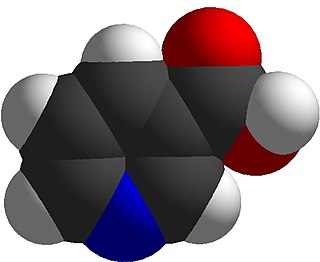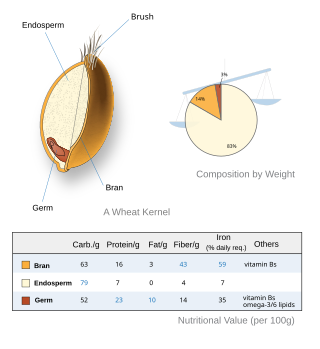
A cereal is any grass cultivated for the edible components of its grain, which is composed of an endosperm, a germ, and a bran. Cereal grain crops are grown in greater quantities and provide more food energy worldwide than any other type of crop and are therefore staple crops. They include rice, wheat, rye, oats, barley, millet and maize. Edible grains from other plant families, such as buckwheat, quinoa and chia, are referred to as pseudocereals.

Hominy is a food produced from dried maize (corn) kernels that have been treated with an alkali, in a process called nixtamalization. "Lye hominy" is a type of hominy made with lye.

Kwashiorkor a form of severe protein malnutrition characterized by edema and an enlarged liver with fatty infiltrates. It is thought to be caused by sufficient calorie intake, but with insufficient protein consumption, which distinguishes it from marasmus. Recent studies have found that a lack of antioxidant micronutrients such as β-carotene, lycopene, other carotenoids, and vitamin C as well as the presence of aflatoxins may play a role in the development of the disease. However, the exact cause of kwashiorkor is still unknown. Inadequate food supply is correlated with occurrences of kwashiorkor; occurrences in high income countries are rare. It occurs amongst weaning children to ages of about five years old.

Niacin, also known as nicotinic acid, is an organic compound and a vitamer of vitamin B3, an essential human nutrient. It can be manufactured by plants and animals from the amino acid tryptophan. Niacin is obtained in the diet from a variety of whole and processed foods, with highest contents in fortified packaged foods, meat, poultry, red fish such as tuna and salmon, lesser amounts in nuts, legumes and seeds. Niacin as a dietary supplement is used to treat pellagra, a disease caused by niacin deficiency. Signs and symptoms of pellagra include skin and mouth lesions, anemia, headaches, and tiredness. Many countries mandate its addition to wheat flour or other food grains, thereby reducing the risk of pellagra.

The chickpea or chick pea is an annual legume of the family Fabaceae, subfamily Faboideae. Its different types are variously known as gram or Bengal gram, chhana, chana, or channa, garbanzo or garbanzo bean, or Egyptian pea. Chickpea seeds are high in protein. It is one of the earliest cultivated legumes, and 9500-year-old remains have been found in the Middle East.

In North America, a corn tortilla or just tortilla is a type of thin, unleavened flatbread, made from hominy, that is the whole kernels of maize treated with alkali to improve their nutrition in a process called nixtamalization. A simple dough made of ground, dried hominy, salt and water is then formed into flat discs and cooked on a very hot surface, generally an iron griddle called a comal.
An essential amino acid, or indispensable amino acid, is an amino acid that cannot be synthesized from scratch by the organism fast enough to supply its demand, and must therefore come from the diet. Of the 21 amino acids common to all life forms, the nine amino acids humans cannot synthesize are valine, isoleucine, leucine, methionine, phenylalanine, tryptophan, threonine, histidine, and lysine.

In agriculture, milpa is a field for growing food crops and a crop-growing system used throughout Mesoamerica, especially in the Yucatán peninsula, in Mexico. The word milpa derives from the Nahuatl phrase mil-pa. Based on the agronomy of the Maya and of other Mesoamerican peoples, the milpa system is used to produce crops of maize, beans, and squash without employing artificial pesticides and artificial fertilizers.

Pellagra is a disease caused by a lack of the vitamin niacin (vitamin B3). Symptoms include inflamed skin, diarrhea, dementia, and sores in the mouth. Areas of the skin exposed to either sunlight or friction are typically affected first. Over time affected skin may become darker, stiffen, peel, or bleed.

Masa is a maize dough that comes from ground nixtamalized corn. It is used for making corn tortillas, gorditas, tamales, pupusas, and many other Latin American dishes. It is dried and powdered into a flour form called masa harina. Masa is reconstituted from masa harina by mixing with water before use in cooking.

The International Maize and Wheat Improvement Center is a non-profit research-for-development organization that develops improved varieties of wheat and maize with the aim of contributing to food security, and innovates agricultural practices to help boost production, prevent crop disease and improve smallholder farmers' livelihoods. CIMMYT is one of the 15 CGIAR centers. CIMMYT is known for hosting the world's largest maize and wheat genebank at its headquarters in Mexico.

Nixtamalization is a process for the preparation of corn, or other grain, in which the grain is soaked and cooked in an alkaline solution, usually limewater, washed, and then hulled. The term can also refer to the removal via an alkali process of the pericarp from other grains such as sorghum.

A whole grain is a grain of any cereal and pseudocereal that contains the endosperm, germ, and bran, in contrast to refined grains, which retain only the endosperm.

Hartnup disease is an autosomal recessive metabolic disorder affecting the absorption of nonpolar amino acids. Niacin is a precursor to nicotinamide, a necessary component of NAD+.
Zeism is any condition attributed to excessive use of maize (corn) in the diet, such as pellagra. Maize is low in zinc, niacin, and tryptophan, and the limited niacin found in maize is not absorbed in the digestive tract unless it has been treated with alkalis, as in the preparation of tortillas. A type of pellagra attributed to amino acid imbalance is common in India among people who eat a millet with a high leucine content. The deficiencies are usually seasonal.
Evangelina Villegas was a Mexican cereal biochemist whose work with maize led to the development of quality protein maize (QPM). She and her colleague from the International Maize and Wheat Improvement Center (CIMMYT), Surinder Vasal, shared the 2000 World Food Prize for this achievement. Villegas was the first woman to ever receive the World Food Prize.

Proteins are essential nutrients for the human body. They are one of the building blocks of body tissue and can also serve as a fuel source. As a fuel, proteins provide as much energy density as carbohydrates: 4 kcal per gram; in contrast, lipids provide 9 kcal per gram. The most important aspect and defining characteristic of protein from a nutritional standpoint is its amino acid composition.
Protein combining or protein complementing is a dietary theory for protein nutrition that purports to optimize the biological value of protein intake. According to the theory, vegetarian and vegan diets may provide an insufficient amount of some essential amino acids, making protein combining with multiple foods necessary to obtain a complete protein food. The terms complete and incomplete are outdated in relation to plant protein. The position of the Academy of Nutrition and Dietetics is that protein from a variety of plant foods eaten during the course of a day supplies enough of all essential amino acids when caloric requirements are met.

Thomas Burr Osborne was a biochemist who, with Lafayette Mendel, independently discovered Vitamin A, though Elmer McCollum and Marguerite Davis were ultimately given credit, as they had submitted their paper first by three weeks. He is known for his work isolating and characterizing seed proteins, and for determining protein nutritional requirements. His career was spent at the Connecticut Agricultural Experiment Station.

Vitamin B3, colloquially referred to as niacin, is a vitamin family that includes three forms or vitamers: niacin (nicotinic acid), nicotinamide (niacinamide), and nicotinamide riboside. All three forms of vitamin B3 are converted within the body to nicotinamide adenine dinucleotide (NAD). NAD is required for human life and people are unable to make it within their bodies without either vitamin B3 or tryptophan. Nicotinamide riboside was identified as a form of vitamin B3 in 2004.















